Interview with Beckey Waldrop, Miller Waldrop Furniture & Decor
Design- oriented
retailer shares success strategies for hiring design associates, product
display creation and integrating in-store design areas into its sales
plan.
Miller Waldrop Furniture & Decor operates four stores in West Texas and
Southeastern New Mexico. It’s a third-generation family-run operation owned
by a husband-and-wife team, Kent and Beckey Waldrop. The store is a member
of the Furniture First national buying group. Beckey is currently a member
of Furniture First’s board of directors. “Kent’s family owned Miller Waldrop
Furniture, as well as a bed, bath and kitchen store we closed in 2000 to
more fully focus on our furniture business,” Beckey Waldrop told Furniture
World. “I buy and manage inventory for almost every product category at
Miller Waldrop, as well as oversee our office and sales departments. Kent
enjoys buying mattresses and recliners for our three main stores and one
free-standing Furniture First mattress store. He also manages the back end,
advertising, service and delivery portions of our business.
”I learned on the job, helped by people like Wayne and David McMahon at
PerformNow.They’ve consulted with Miller Waldrop, and we are in one of
David’s performance groups.”
Miller Waldrop’s original store is in Hobbs, New Mexico, a town with a
population under 50,000. Their largest market is Lubbock, Texas, with a
population of just over 350,000.
“I would say,” said Waldrop, “that even our largest market would probably be
considered rural. Texas Tech University is there, so our customers in
Lubbock skew younger. In Hobbs, we are the only furniture store in town
other than Ashley Furniture.”
Design Services
“Our store in Hobbs has been around for over 70 years, so shoppers there
know us and come in for design help. Success in providing design services is
something that must be developed and worked on over time.
“Some of our best design-focused salespeople at Miller Waldrop previously
sold cars.
Many of these folks were trained in a dog-eat-dog world. ”
“For many years, I worked on the design side of our business. Our more
affluent customers would ask for me. If we did a Parade home or any kind of
staging, I would do that work as well, which was very satisfying.”
Waldrop says that in their growing family business, it was great to bring in
a $300,000 sale based on her interior design work with clients, but the
demands of buying and managing inventory created a trade-off, making it
necessary to hire people with design skills, including some with interior
design degrees, to fill the void.
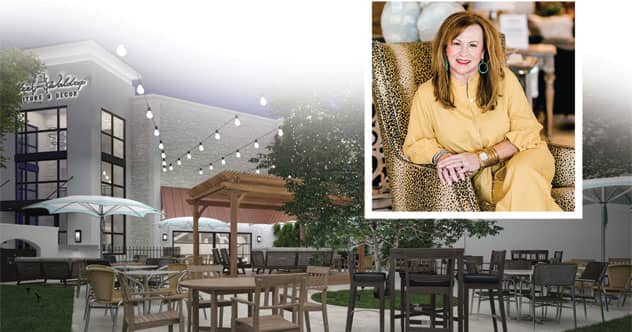
Design Staffing
“Our experience has shown that there’s more to being a good in-store
designer than having a degree,” Waldrop observed. “It’s difficult to teach
design because it’s so subjective. I realize that a lot of people would not
agree with me, but that’s my experience. Some people just have a knack for
choosing the right balance and color.
“That’s why we tend to promote design staff from within the company. These
are generally salespeople who’ve already proven they can do the job.
Occasionally, we do hire designers from outside of the Miller Waldrop
organization.
“Talent and experience are critical for any sales position, but the ability
to build relationships is an essential skill. Some of the very best
design-focused salespeople at Miller Waldrop previously sold cars. Many of
these folks were trained in a dog-eat-dog world. They love that they can
make the same amount of money or more at Miller Waldrop while developing
their design abilities. Discount Furniture?
“One of our best associates with a background in car sales routinely works
on $150,000-plus projects. While working here at Miller Waldrop, she
developed the knack because she had an interest in design and paid attention
as we set up in-store vignettes together.
“Outside designers get a higher commission, which we treat as an
advertising expense.
It makes sense to look at it that way.”
“We also work with outside design consultants, some who have longstanding
relationships with us. Designers bring their customer relationships to the
table, and we provide them with incentives. Our salespeople place custom
orders, handle paperwork and coordinate deliveries. They give up some
commission when working with outside designers. The designers get a higher
commission percent, which we treat as an advertising expense. It makes sense
to look at it that way, because they bring in their customers just like a
promotion or television ad would.”
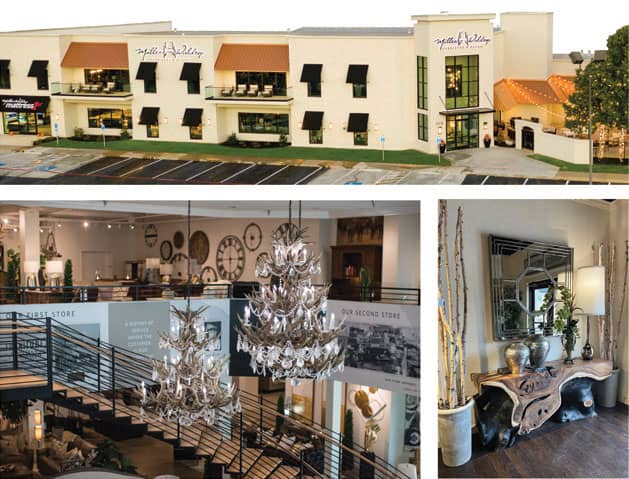
Design Service Process
Furniture World asked Waldrop to explain how Miller Waldrop helps customers
begin the process of designing rooms. She replied that the best way to
introduce design services is just to be friendly and not act like a typical
furniture salesperson.
“It’s about making a connection with customers from the beginning. That
helps shoppers to feel comfortable, open up and start talking.
“Once they open up, we may discover that they don’t need or want design
services. If they already know what they want, that’s fine. But, if they
waiver, ask questions or let us know about a particular problem that needs
to be solved, it presents an easy path to offer design assistance.
“I believe that much of our success in this area results from training
salespeople to find these opportunities. They look for indecision and other
cues to open the door to get into clients’ homes for house calls. Not all
our salespeople can do this effectively, so we have systems in place for
design specialists to come in, offer help, and get the job done.”tem, we buy
a lot of it so that they can manufacture with confidence.”
Since Miller Waldrop’s design services are free, there’s no need for a sales
pitch and no obstacles for shoppers who consider taking advantage of the
service.
“Once the process starts with a client,” Waldrop continued, “Miller
Waldrop’s design staff needs to schedule the next appointment to keep the
process moving along smoothly. This next appointment might be for a house
call visit or for the customer to return with measurements.
“Throughout the process, we also try to make our furniture and accessory
suggestions work with furnishings that customers already own. And, we always
put our design customers’ needs and vision for their spaces first.
Oftentimes, however, our customers need to be shown what’s possible. That’s
why we frequently bring accessories and other items from the store into
their homes for their consideration. It takes some additional effort, but
it’s a great way to enhance customers’ rooms and build sales.”
Store Design
When Kent and Beckey Waldrop decided to open their most recent store in
Lubbock, they looked at purchasing a building that previously housed a
furniture store. “It needed work,” Waldrop recalled, “so we brought in store
designer Martin Roberts. He created the initial concept for the store’s
exterior.
“When COVID hit, we decided not to go through with the purchase. As the
pandemic progressed, we were able to buy that same building at a steep
discount.
“In the meantime, our good friend Martin had passed away, so Jennifer Magee
stepped in to finish the project. She did an outstanding job and helped us
develop our in-store design center concept as well as finish up other store
concepts we envisioned with Martin.”
Miller Waldrop’s Design Center
“Our centrally located, well-equipped design center communicates to shoppers
we are different than other stores that don’t focus on offering design
services,” continued Waldrop. “It has all the tools, including big screens
and work centers, beautiful lighting, plus inviting spaces for our designers
to work with customers. When shoppers see this area, they feel like they
want to go in and play with their designs.”
Customers can coordinate furniture and accessory choices to visualize how
their homes will look. “Often, salespeople will make an appointment with
customers to view staged room settings that they’ve set up in the design
center,” she said. “That way, they can swap out accessories, play around
with the design and try out different sizes.”
“Being a store that carries higher-end lines,
I used to be proud that we didn’t carry Ashley Furniture.”
Design Shifts
Furniture World asked Beckey Waldrop how shoppers’ attitudes about home
design and home furnishings have changed.
“We’ve seen a major design shift,” she replied. “Over the last 10 years
consumer preferences for home furnishings went from dark and traditional to
very light, cleaner and more contemporary.
“Being a store that carries higher-end lines, I used to be proud that we
didn’t carry Ashley Furniture. Then, about five years ago, a fellow
Furniture First retailer who owns a high-end design store in South Dakota
suggested that it might be a good idea for us to carry the line. The
decision to carry Ashley turned out to be sound advice that changed our
buying strategy.
“Today, customers are spending a little bit less on furniture but replacing
it more often. That’s been a huge bonus for furniture retailers like us.”
Miller Waldrop still carries the higher end, but has added lower-priced
merchandise into the mix, especially in stores that appeal to younger
shoppers.
“We have a centrally located, well-equipped design center that
communicates to shoppers we are different from other stores that don’t
focus on offering design services.
It has all the tools.”
Other Trends
Multi-Use Furniture: “Furniture that’s multi-use has grown
in popularity, such as sofa tables that can also be used as a dining table,
a bar or a desk.”
Open Floor Plans are Back: “During COVID, when people were
stuck at home, we noticed, as did a lot of other furniture retailers, that
customers were looking to create private, specialized areas, especially for
work and study. That trend didn’t stick. Our customers overwhelmingly want
open floor plans with furnishings that are coordinated and flow together.
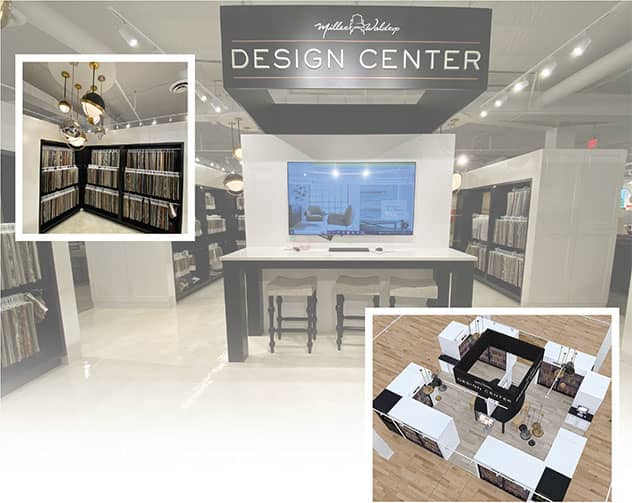
“This is a big consideration for me as a buyer. When I buy a living room
set, I also need to think about dining sets we will need to display that
will create those coordinated looks.”
“Our customers overwhelmingly want open floor plans and furnishings that
coordinate and flow together.”
Lifestyle Product Preferences: “Many of our older customers
want to purchase more traditional styles in darker colors, so we have a
traditional lifestyle area displayed across multiple price points. A second
lifestyle area is devoted to the BoHo chic and colorful items favored by our
younger customers. A third area has a monochromatic feel featuring light
colors, creams and whites, but with a whole lot of texture. Right now, we
are showing fabrics that are kind of nubby, and woods with prominent grains.
Each of the three lifestyle areas displayed in our stores features living
room, dining room and kitchen furniture selections that flow together. It’s
proven to be a display technique that works especially well for customers
with newer homes.”
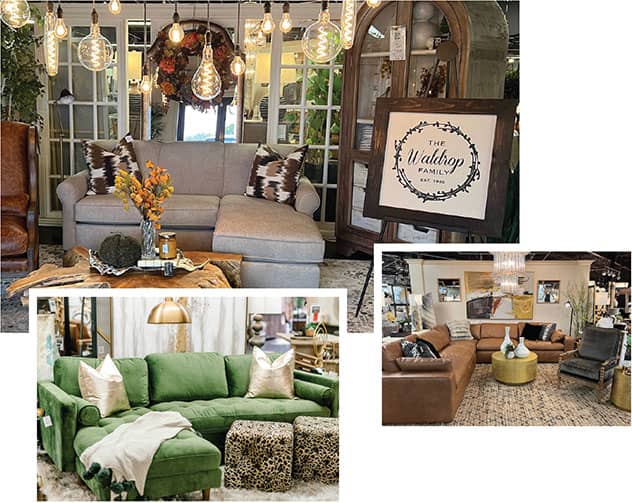 Miller Waldrop Furniture & Decor displays furniture by lifestyle
category in each of its stores.
Miller Waldrop Furniture & Decor displays furniture by lifestyle
category in each of its stores.
Inventory Management
“I believe that Miller Waldrop’s success as a business is based more on the
discipline of inventory management than any design talent I have. It’s a
huge part of what we do as a retailer.
“I keep on top of our best sellers and make a point of talking to the
salespeople to find out what shoppers are asking for that we don’t have.”
Waldrop told Furniture World that successful buyers must pay attention to
design aesthetics as well as manage inventory with a laser focus on sales
and inventory metrics. “It can be difficult to balance these two factors
because it becomes a right brain-left brain puzzle. On one hand, stores must
look beautiful and exciting. It might make good sense to display a stunning
light fixture that creates an eye-catching first impression near the store
entrance, even though from a left-brain perspective it should be on
markdown. In the end, it’s a judgment call that every retail furniture store
operation must figure out. All our stores are heavily accessorized, which
gives us the flexibility, for example, to put a different flavor on a sofa
we bought in depth to create visual excitement.”
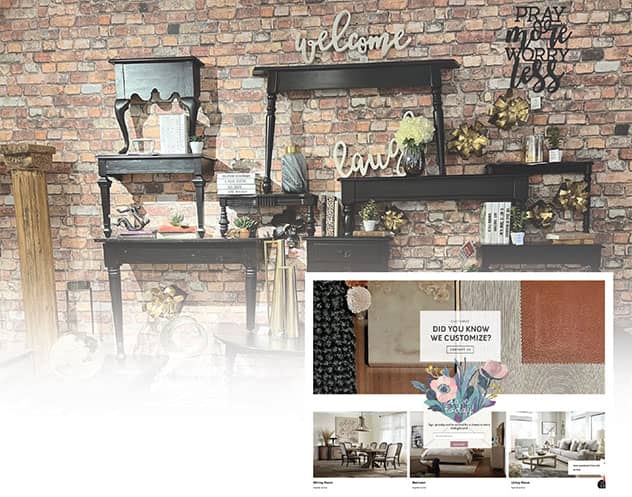 The
www.millerwaldrop.com website
welcomes visitors with a chance to win a $100 gift certificate and
invites inquiries about custom options.
The
www.millerwaldrop.com website
welcomes visitors with a chance to win a $100 gift certificate and
invites inquiries about custom options.
Future Plans
Miller Waldrop Furniture & Decor doesn’t have plans to expand in the next
couple of years. “Our next project,” Beckey Waldrop said, “is to put
executive-level management teams in place. The idea is to have people
managing operational areas at Miller Waldrop, who will report to Kent and
me. Once that’s accomplished, we plan to start growing again.”
“Many furniture retailers can benefit from reading
The E-Myth Revisited: Why Most Small Businesses Don’t Work and What to
Do About It.”
In closing, Beckey Waldrop had one last suggestion for Furniture World
readers who have entrepreneurial family businesses and may be juggling
work-life balance. “Many furniture retailers can benefit from reading “The
E-Myth Revisited: Why Most Small Businesses Don’t Work and What to Do About
It,” she suggested. “It’s about entrepreneurial myths — a very, very good
read. Entrepreneurs often start a business to do something they love and are
good at, but the many demands of running a business require different skill
sets. It’s something that businesses like ours often need to get on top of
to get to the next level.”